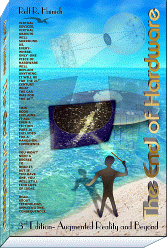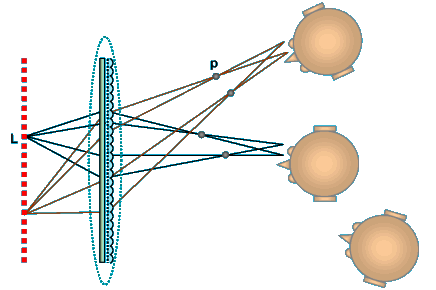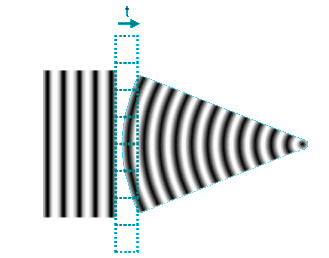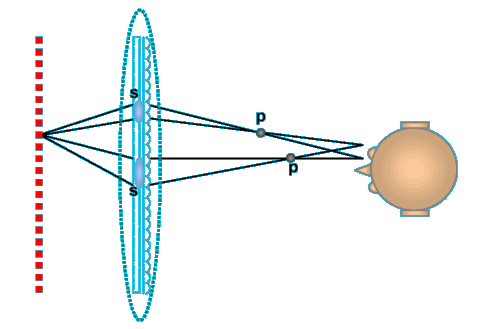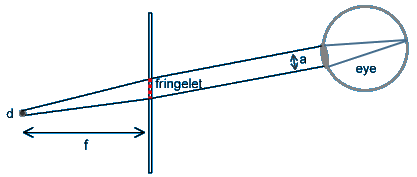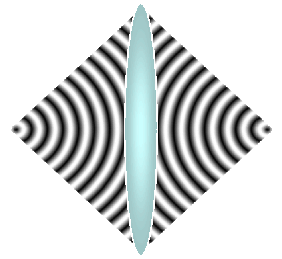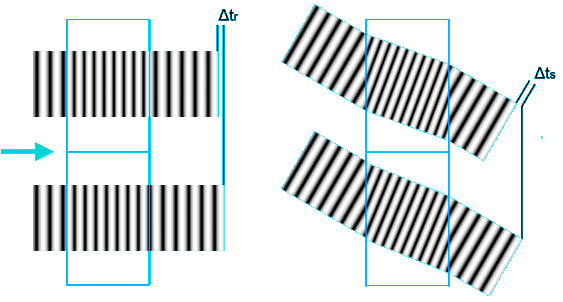Augmented Reality is more than Virtual Reality
A short excursion on auto holographic displays
This is new information, not yet contained in the book. We'll consider its principles and its possible usefulness for augmented reality applications. For some basics about holography that we will use in the following, please refer to the holographic encoding page. Basic information about the technology addressed, you'll find at the SeeReal website.
Please note that due to the non availability of more detailed information, the following considerations may or may not apply to any real products or prototypes.
Principally it remains questionable if this relatively expensive solution, not even a flat display, will be able to acquire a considerable market share. For viewing distances above 6 ft., focus simulation is superfluous, due to the depth of field of the human eye. So this may be a solution just for close-up applications. A much cheaper user adaptive solution we show on another page.
The technology reportedly works with an LC panel display and a Fresnel lens that approximately concentrates the light from a source L behind the display towards one eye of one spectator each. Instead of light sources moving according to the spectators, a laser scanner illuminating spots on a reflective screen could be used, or presumably an array of switched LED or OLED emitters. Sufficiently small and spectrally clean sources might deliver an illumination coherent enough, but not too coherent (which could cause laser speccles and other artifacts).
Fine forming of the beam, e.g. focusing to form virtual image pixels in 3D space, as well as presumably fine positioning (compensation of light source position and distance) is done by forming holographic sub patterns on the display. As the display can modulate the refraction index of its cells, travel time through cells and hence light phase can be modulated to form holographic lenses (symbolic picture).
Here we see holographic sub patterns acting as lenses (s) forming 3D image pixels (p).
The most important progress with these displays presumably is the use of relatively 'large' screen pixels (still small with 20...40 µm, but much larger than in a conventional hologram).
Could the wavefronts from these large pixels still produce interference at the spectator's eyes?
Given the laser beam deviation resulting from the small sources (pixels), essentially being the same formula as shown for lens focusing in the holographic encoding page here, we see that this is the case. The beams overlap almost entirely before reaching the eye.
We see that for the principle of concentrating light to spectator's eyes, the large display pixels even are a necessity. They have to be chosen according to the desired viewing distance range.Another question arising, can these large pixels deliver a consistent interference patterns, i.e. would the phase difference within one pixel be small enough? The pattern contributing to a single 3D image pixel will be equal or smaller than the pupil diameter of the spectator, which is about 2 mm for medium bright light.
As we can easily see from the geometry depicted above, this is given even in a critical case, the spectator being very near to the display. The phase difference from one edge of one display pixel to the other (here 20 µm pixel size assumed) is only 0.1 µm, 1/4 the wavelength of blue light.
At the edges of the display, or in case the spectator is well off center even in the middle of the display, light waves are hitting the display cells at an angle, which in classical holography would require very narrow patterns to cope with this situation.
The above picture illustrates that in case of large beam angles, the phase differences between adjacent display pixels still behave quite similar to the perpendicular case. Large display cells seem to be even necessary here again.
Discussion
This technology reduces complexity by 10000 compared to conventional holography (if we consider image generation for one eye of one observer only). compared to conventional displays however, the pixel count is about 100 times higher, and with multiple observers, it may be a 1000 times. Even then, this is still a giant leap towards really holographic screens, and the tremendous computing power still necessary will be available within a foreseeable future.
What concerns us here, is this technology offering advantages also for display glasses, e.g. in a case where the holographic display is viewed through magnifiers, effectively?
The necessary pixel size in this case may be 4 µm or below, hence much closer to that of a classical hologram (without more complexity, as the display is much smaller). It is questionable if a sufficient phase modulation would then be possible, as the display cells also have to be much thinner. Nevertheless, this display type is also interesting for another reason, as it promises a higher light effectiveness than grating or absorption holograms.
Observer specific pattern generation (here, according to eye movements) as already discussed in the book, as well as 'moving' light sources could be of advantage, particularly allowing to use coarser hologram patterns, but not necessarily with the same display technology.Anyway, this is an interesting development in our context, as at least the virtual 'wall breakthrough' treated in the book's fiction part might become almost perfect with this kind of screen.
What will be most important for any mass market applications to succeed whatsoever, apart from the price of the display, is the availability of truly 3-dimensional movies. The prerequisites for this to achieve have been widely addressed in the book. One major necessity in this context are camera arrays, that will be economically feasible with the upscaling technology. Old materials can also be refurbished with 3D views and resolution upscaling, with new approaches extracting information from differences between subsequent film pictures. May 27, 2007
Obviously the display we have described here, generates holographic image pixels with 'lenses' formed by refraction index variations, rather than by gray value fringes. The display pixel size has to be chosen as to guarantee a sufficiently small stepping of phases between adjacent pixels.
As we have to calculate and overlay as many lens patterns as there are pixels in the image, this still remains a very demanding task.
But there is another possibility, if we decline the fully holographic approach and resign to one of adaptive auto stereoscopy:
Imagine we would place an entire classical LCD panel in our display plane. We again illuminate it by small light sources from behind, and we place a full area Fresnel lens upon the display, so the light from one of these sources is concentrated to one little area in front of the display, where we imagine an observer's eye.This observer then simply sees the entire classical LCD image with this eye.
What we still need is to adjust the focus length of the Fresnel lens, possibly together with a little angular correction, according to the observer's distance. This could again be done with a refraction changing, second LCD panel. In this case however, we would only need one or a small selection of patterns, stretching over the entire display area, that don't have to be calculated every time but could come from a memory, possibly even integrated into the very screen itself (if it would really work, has to be further investigated). If we use the spot of a laser scanner beam on a projection screen as a deliberately movable light source, the hologram optics would have to deliver focus adaptation only and would even become much simpler.
The only demanding task here would be to supply enough images for the eyes of many users sequentially. Hence, an HD display with somewhere about 10x the usual frame rate.Compared to the full approach, this requires orders of magnitude less calculations and bandwidth. Even if eye focusing isn't reproduced point by point in this case, it could be an auto stereoscopic approach more versatile than anything existing so far, and it would also need very little energy, as large part of the light is concentrated directly towards the observer. One disadvantage, like with the full approach as well: this would not really be a flat screen. Some depth for the light sources is necessary.
Concerning display glasses, the approach could perhaps also be used for dynamic focusing. In this case, the pixel size of the conventional and the refractive display could perhaps even be equal, allowing for a completely integrated construction that could possibly eliminate the necessity of mechanical focusing system. July 15, 2007
Concerning large 3D displays, even the 'simpler' variety remains extremely complex and expensive. Special lenticular arrays instead, will allow for really cheap solutions. More here.
home more notes order
Copyright © 2006-2011 Rolf R. Hainich; all materials on this website are copyrighted.
Disclaimer: All proprietary names and product names mentioned are trademarks or registered trademarks of their respective owners. We do not imply that any of the technologies or ideas described or mentioned herein are free of patent or other rights of ourselves or others. We do also not take any responsibility or guarantee for the correctness or legal status of any information in this book or this website or any documents or links mentioned herein and do not encourage or recommend any use of it. You may use the information presented herein at your own risk and responsibility only. To the best of our knowledge and belief no trademark or copyright infringement exists in these materials. In the fiction part of the book, the sketches, and anything printed in special typefaces, names, companies, cities, and countries are used fictitiously for the purpose of illustrating examples, and any resemblance to actual persons, living or dead, organizations, business establishments, events, or locales is entirely coincidental. If you have any questions or objections, please contact us immediately. "We" in all above terms comprises the publisher as well as the author. If you intend to use any of the ideas mentioned in the book or this website, please do your own research and patent research and contact the author.
